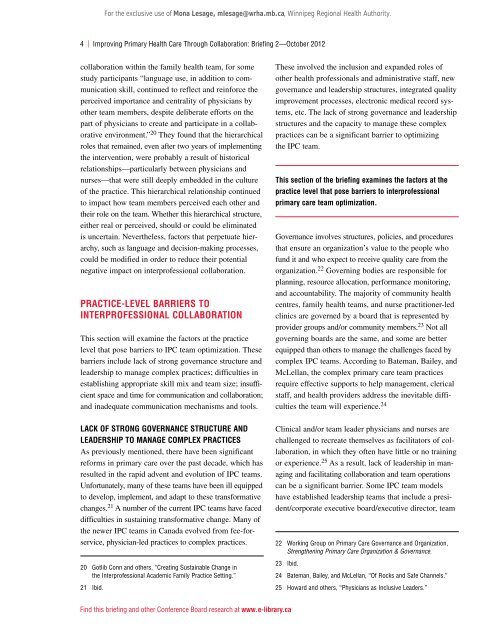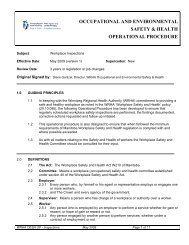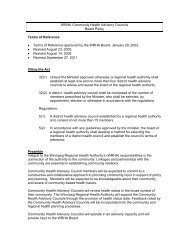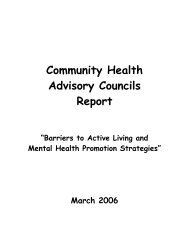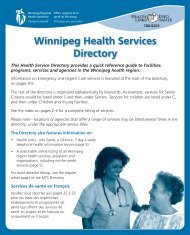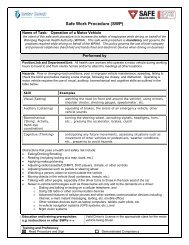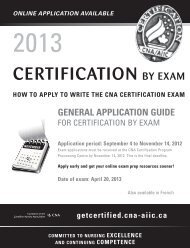Improving Primary Health Care Through Collaboration: Briefing 2 ...
Improving Primary Health Care Through Collaboration: Briefing 2 ...
Improving Primary Health Care Through Collaboration: Briefing 2 ...
- No tags were found...
Create successful ePaper yourself
Turn your PDF publications into a flip-book with our unique Google optimized e-Paper software.
For the exclusive use of Mona Lesage, mlesage@wrha.mb.ca, Winnipeg Regional <strong>Health</strong> Authority.4 | <strong>Improving</strong> <strong>Primary</strong> <strong>Health</strong> <strong>Care</strong> <strong>Through</strong> <strong>Collaboration</strong>: <strong>Briefing</strong> 2—October 2012collaboration within the family health team, for somestudy participants “language use, in addition to communicationskill, continued to reflect and reinforce theperceived importance and centrality of physicians byother team members, despite deliberate efforts on thepart of physicians to create and participate in a collaborativeenvironment.” 20 They found that the hierarchicalroles that remained, even after two years of implementingthe intervention, were probably a result of historicalrelationships—particularly between physicians andnurses—that were still deeply embedded in the cultureof the practice. This hierarchical relationship continuedto impact how team members perceived each other andtheir role on the team. Whether this hierarchical structure,either real or perceived, should or could be eliminatedis uncertain. Nevertheless, factors that perpetuate hierarchy,such as language and decision-making processes,could be modified in order to reduce their potentialnegative impact on interprofessional collaboration.Practice-Level Barriers toInterprofessional <strong>Collaboration</strong>This section will examine the factors at the practicelevel that pose barriers to IPC team optimization. Thesebarriers include lack of strong governance structure andleadership to manage complex practices; difficulties inestablishing appropriate skill mix and team size; insufficientspace and time for communication and collaboration;and inadequate communication mechanisms and tools.These involved the inclusion and expanded roles ofother health professionals and administrative staff, newgovernance and leadership structures, integrated qualityimprovement processes, electronic medical record systems,etc. The lack of strong governance and leadershipstructures and the capacity to manage these complexpractices can be a significant barrier to optimizingthe IPC team.This section of the briefing examines the factors at thepractice level that pose barriers to interprofessionalprimary care team optimization.Governance involves structures, policies, and proceduresthat ensure an organization’s value to the people whofund it and who expect to receive quality care from theorganization. 22 Governing bodies are responsible forplanning, resource allocation, performance monitoring,and accountability. The majority of community healthcentres, family health teams, and nurse practitioner-ledclinics are governed by a board that is represented byprovider groups and/or community members. 23 Not allgoverning boards are the same, and some are betterequipped than others to manage the challenges faced bycomplex IPC teams. According to Bateman, Bailey, andMcLellan, the complex primary care team practicesrequire effective supports to help management, clericalstaff, and health providers address the inevitable difficultiesthe team will experience. 24Lack of Strong Governance Structure andLeadership to Manage Complex PracticesAs previously mentioned, there have been significantreforms in primary care over the past decade, which hasresulted in the rapid advent and evolution of IPC teams.Unfortunately, many of these teams have been ill equippedto develop, implement, and adapt to these transformativechanges. 21 A number of the current IPC teams have faceddifficulties in sustaining transformative change. Many ofthe newer IPC teams in Canada evolved from fee-forservice,physician-led practices to complex practices.20 Gotlib Conn and others, “Creating Sustainable Change inthe Interprofessional Academic Family Practice Setting.”21 Ibid.Clinical and/or team leader physicians and nurses arechallenged to recreate themselves as facilitators of collaboration,in which they often have little or no trainingor experience. 25 As a result, lack of leadership in managingand facilitating collaboration and team operationscan be a significant barrier. Some IPC team modelshave established leadership teams that include a president/corporateexecutive board/executive director, team22 Working Group on <strong>Primary</strong> <strong>Care</strong> Governance and Organization,Strengthening <strong>Primary</strong> <strong>Care</strong> Organization & Governance.23 Ibid.24 Bateman, Bailey, and McLellan, “Of Rocks and Safe Channels.”25 Howard and others, “Physicians as Inclusive Leaders.”Find this briefing and other Conference Board research at www.e-library.ca


